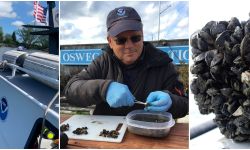Cancer-causing hexavalent chromium spills from Wixom plant into Huron River

- “Several thousand gallons” of liquid containing hexavalent chromium have spilled into the Huron River
- The compound has been linked to cancer and other health problems
- State regulators are urging people not to play in or drink from the river until further notice
Aug. 12: Reports: Huron River largely dodged hexavalent chromium scare
Aug. 10: State: Tribar staffer ignored 460 alarms in Huron River chromium release
Aug. 9: Huron River chromium spill prompts call for stricter Michigan pollution law
Aug. 4: Latest Huron River tests find no cancer-causing chromium; advisory remains
WIXOM — For the second time in four years, a Wixom auto supplier is behind a massive release of industrial contamination into the Huron River, according to Michigan environmental regulators. The state said “several thousand gallons” of liquid containing cancer-causing hexavalent chromium were spilled, beginning as early as Saturday.
Michigan health and environment officials urge area residents to avoid “all contact” with a stretch of Huron River after the company, Tribar Manufacturing, released the 5 percent hexavalent chromium solution into the Wixom sewer system, where it then went through the city wastewater treatment plant and out to the river.
Ann Arbor, well downstream from Wixom on the 104-mile river, gets most of its drinking water from the Huron. But officials said there is no immediate threat to drinking water. Sampling is ongoing to determine the location and extent of the chromium plume in the river.

Kayakers on the Argo Cascades along the Huron River in Ann Arbor. State regulators said Ann Arbor is the closest drinking water intake from the site of the spill in Wixom. (Shutterstock photo, Susan Montgomery)
Prior to the current spill, Tribar was responsible for much of the PFAS contamination that resulted in widespread, years-long fish consumption advisories in communities surrounding the Huron River.
Nick Travers, the company’s Human Resources director, declined comment to Bridge Michigan on the chemical release or its cause Tuesday, saying the company will issue a press release on Wednesday.
Hexavalent chromium, also known as chromium-6, is a toxic compound and a large body of research has linked chromium compounds to lung cancer and a host of other health issues, including asthma and bronchitis.
In Michigan, state health officials Tuesday warned residents to avoid “all contact” with the section of the Huron River stretching from North Wixom Road in Oakland County to Kensington Road in Livingston County. That includes Hubble Pond, also known as Mill Pond, and North Creek downstream from the Wixom Wastewater Treatment Plant in Oakland County and Kent Lake, which straddles the counties.
Residents are being advised against swimming, wading or otherwise playing in the Huron River. They are not to drink the water, eat fish caught in that section of the river, nor water plants or the lawn with it.
The advisory extends to pets.
The Michigan Department of Environment, Great Lakes and Energy (EGLE) is testing at the facility and water plant and sampling the river at multiple locations downstream of the Wixom treatment plant, attempting to discern the extent of the contamination. Results are expected in the coming days.
The water treatment plant is designed to handle sewage, not chemical compounds such as chromium-6, said Mark Hansell, an environmental programs chief in the Oakland County Health Division.
After being treated at the plant, the water is discharged into Norton Creek, and then flows into Huron River toward Ann Arbor, which pulls from the Huron River for its drinking water.
Given the flow of the river, it could take “several weeks” before the chromium-6 reaches Ann Arbor’s water plant intakes, Hansell said.
More immediately, the Michigan Department of Natural Resources and Kensington Metroparks will post no-contact advisories around Kent Lake and the Island Lake Recreation Area, respectively, said Matt Bolang, acting health officer for Livingston County.
As for any longer-term impact, “that’s the million-dollar question,” said Oakland's Hansell, who said was a “major talking point” in meetings with state and local officials Tuesday.
“We know a spill occurred, and we simply do not know what the impact is going to be once it passed through the treatment plant,” he said.
Also unclear is how long the health advisories will remain in place.
Elizabeth Hertel, director of the Michigan Department of Health and Human Services, suggested the recommendations "may change or be expanded" as the investigation develops.
According to the state, Tribar officials first discovered the chemical's release into local sewers at 8 a.m. Monday, but Tribar did not alert EGLE until 3:21 p.m. — a more than seven hour gap. The company told regulators the leak may have been ongoing since Saturday.
Industry adds chromium to iron and nickel to harden steel and create corrosion-resistant metal alloys. Hexavalent chromium is also used in leather tanning, glass-making and paint pigment for fabrics.
It is particularly toxic when breathed, ingested or touched. Humans can tolerate some forms of it in very small amounts.
Earlier this year, Environmental Working Group, a Washington-based environmental research nonprofit, found that tap water for 251 million Americans was contaminated by unsafe hexavalent chromium levels. The group created an interactive map by compiling federal and state water testing data.
Chromium-6 also was the toxin at the center of the movie about Erin Brokovich, a dramatization of real-life environmental pollution involving an energy company. It gained attention in Michigan in 2019 when groundwater contaminated with the chemical formed a “green ooze” on I-96 in Madison Heights as it bubbled up from underground. The source: A shuttered metal-plating operation.
Jeff Gearhart, research director at the Ann Arbor-based Ecology Center, called chromium-6 “nasty stuff,” so much so, he said, that “substantially-responsible, ethical companies have stopped using it.”
Concerned with its links to cancer and other health problems among industrial workers, several automakers restrict its use in auto parts, as does the European Union, he said.

That chromium-6 is still used locally for manufacturing auto parts is surprising, Gearhart said.
“I would call this kind of medieval chemistry to plate their stuff. I mean, this is a known carcinogen,” he said. “It should be clear that it shouldn't be used anymore.
“Any related human exposure will be of concern,” he said.

This week's Wixom spill is but the latest public health crisis to befall the river, the central artery of a watershed covering 900 square miles across southeast Michigan before pouring into Lake Erie.
The Huron is already subject to do-not-eat advisories for fish as a result of PFAS pollution that also originated from Tribar. PFAS levels in fish tissue have begun declining since Tribar installed filters to clean its effluent.
But PFAS “forever chemicals” remain in the environment, meaning anything no longer present in the Huron has likely washed downstream to pollute Lake Erie.
And as Bridge also reported, in February, state regulators were called to a stretch of the Huron River in Flat Rock, after anglers noticed an iridescent sheen that appeared to be bubbling up from under the surface.
“This is an exercise we've done in the past — to put up public signage,” said Bolang, the health officer in Livingston County.
But while the previous signs involving PFAS warned residents not to eat the fish, “this is a little bit different messaging: Do not come in contact with water,” he said.
And it’s another blow to Bruce Heavner’s business.

Heavner, co-owner of Heavner Canoe & Kayak Rental near Milford, spent Tuesday afternoon breaking the bad news to paddlers after learning about the contamination.
The canoe livery, which the Heavner family has operated for three generations, is located just upstream of the spill zone. About half of a typical day’s business comes from paddlers traveling downstream.
So when Heavner learned of the contamination, he quickly called Maureen DeFrance and her family, sending a van to pick up the paddlers halfway through their afternoon excursion.
By then, DeFrance said, the family had already playfully splashed one another with plenty of water, unaware of the risk.

“It’s a real shame,” said DeFrance, adding, “we need to go home and shower.”
After 30-plus years recreating on the river, she said, she’s angered to know that the same company largely responsible for the “do not eat” advisories lining the shores has also canceled her river recreation plans for the foreseeable future.
“Slapping their hands doesn’t seem to work,” she said. “Make them clean it up.”
Fed up with impacts to his business resulting from the same company’s repeated releases, Heavner said he’s now considering next steps.

“We were just discussing amongst ourselves if it’s something we need to take some legal action against,” he said. “It’s not just the loss of revenue. It’s the loss of experience.”
The current chromium spill is another setback, said Daniel Brown, watershed planner for the Huron River Watershed Council. Brown described it as “heartbreaking and devastating.”
“All the communities have put a lot of effort into restoring and cleaning up the Huron River over decades,” Brown said. “So then to have something happen like this, would be just awful.”
It’s also troubling for the city of Ann Arbor, which gets 85 percent of its drinking water from the Huron River. There, a widening plume of groundwater contaminated with dioxane has already tainted drinking water wells in western Ann Arbor and Scio Township. The contamination stems from the former Gelman Science manufacturing plant.
Brown pointed to those layered crises – each stemming from industrial pollution – as evidence that Michigan is at “a point of reckoning” over policies that put “the profits of polluters over public health.”
State laws and policies that have failed to contain industrial pollution or hold polluters accountable after-the-fact, he said, and efforts to improve Michigan’s polluter pay laws have repeatedly faltered.
“it all comes back to keeping these things out of the environment to begin with, making sure we hold polluters accountable.”
Michigan Environment Watch
Michigan Environment Watch examines how public policy, industry, and other factors interact with the state’s trove of natural resources.
- See full coverage
- Subscribe
- Share tips and questions with Bridge environment reporter Kelly House
Michigan Environment Watch is made possible by generous financial support from:
Our generous Environment Watch underwriters encourage Bridge Michigan readers to also support civic journalism by becoming Bridge members. Please consider joining today.
See what new members are saying about why they donated to Bridge Michigan:
- “In order for this information to be accurate and unbiased it must be underwritten by its readers, not by special interests.” - Larry S.
- “Not many other media sources report on the topics Bridge does.” - Susan B.
- “Your journalism is outstanding and rare these days.” - Mark S.
If you want to ensure the future of nonpartisan, nonprofit Michigan journalism, please become a member today. You, too, will be asked why you donated and maybe we'll feature your quote next time!






